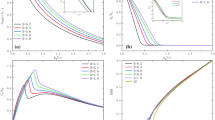Abstract
Chaos-based potentials are defined and implemented in the one-dimensional tight-binding model as a way of simulating disorder-controlled crystalline lattices. In this setting, disorder is handled with the aid of the chaoticity parameter. The inverse participation ratio (IPR) probes the response of the system to three different such potentials and shows consistent agreement with results given by the Lyapunov exponent \(\mathrm{Ly}\): the greater \(\mathrm{Ly}(r)\) for the chaotic sequence as a function of the chaoticity parameter r, the greater the asymptotic value IPR(r) for the large-system ground state.







Similar content being viewed by others
Notes
To the best of the authors’ knowledge, this was first proposed by C. R. de Oliveira (personal communication, 2002).
References
Allouche J-P (1997) Schrödinger operators with Rudin–Shapiro potentials are not palindromic. J Math Phys 38(4):1843–1848
Anderson PW (1958) Absence of diffusion in certain random lattices. Phys Rev 109:1942–1958
Ashcroft NW, Mermin ND (1976) Solid state physics. Brooks-Cole, Pacific Grove
Axel F, Gratias D (eds) (1995) Beyond quasicrystals. Les Editions de Physique and Springer-Verlag
Axel Françoise, Terauchi Hiraku (1991) High-resolution X-ray-diffraction spectra of Thue–Morse GaAs-AlAs heterostructures: towards a novel description of disorder. Phys Rev Lett 66(17):2223–2226
Bovier Anton, Ghez Jean-Michel (1995) Remarks on the spectral properties of tight-bindind and Kronig–Penney models with substitution sequences. J Phys A Math Gen 28:2313–2324
DiVincenzo DP, Steinhardt P (eds) (1991) Quasicrystals: the state of the art. World Scientific Publishing Co.,
Dulea Mihnea, Johansson Magnus, Riklund Rolf (1992a) Localization of electrons and electromagnetic waves in a deterministic aperiodic system. Phys Rev B 45(1):105–114
Dulea Mihnea, Johansson Magnus, Riklund Rolf (1992b) Trace-map invariant and zero-energy states of the tight-binding Rudin–Shapiro model. Phys Rev B 46(6):3296–3304
Dulea Mihnea, Johansson Magnus, Riklund Rolf (1993) Unusual scaling of the spectrum in a deterministic aperiodic tight-bindind model. Phys Rev B 47(14):8547–8551
Evers F, Mirlin AD (2000) Fluctuations of the inverse participation ratio at the Anderson transition. Phys Rev Lett 84(16):3690–3693
Gong L, Wang H, Cheng W, Zhao S (2015) A measurement of disorder in binary sequences. Phys A 422:66–72
Grebogi Celso, Ott Edward, Pelikan Steven, Yorke James A (1984) Strange attractors that are not chaotic. Phys D 13:261–268
Heagy JF, Hammel SM (1994) The birth of strange nonchaotic attractors. Phys D 70:140–153
Hilborn RC (2000) Chaos and nonlinear dynamics—an introduction for scientists and engineers. Oxford University Press, Oxford
Iochum B, Raymond L, Testard D (1992) Resistance of one-dimensional quasicrystals. Phys A 187:353–368
Katsanos DE, Evangelou SN, Xiong SJ (1995) Quantum electron dynamics in periodic and aperiodic sequences. Phys Rev B 51(2):895–904
Kramer Bernhard, MacKinnon Angus (1993) Localization: theory and experiment. Rep Prog Phys 56:1469–1564
Luck JM (1989) Cantor spectra and scaling of gap widths in deterministic aperiodic systems. Phys Rev B 39(9):5834–5849
Ludlam Jonathan J (2004) Localisation of the Vibrations of Amorphous Materials, Ph.D. thesis, Trinity College, Cambridge, UK
Merlin R, Bajema K, Clarke Roy, Juang F-Y, Bhattacharya PK (1985) Quasiperiodic GaAs-AlAs heterostructures. Phys Rev Lett 55(17):1768–1770
Mizoguchi Kohji, Matsutani Kei, Nakashima Shinichi, Dekorsy Thomas, Kurz Heinrich (1997) Observation of coherent acoustic phonons in Fibonacci superlattices. Phys Rev B 55(15):9336–9339
Monthus C, Garel T (2010) Anderson localization of phonons in dimension d = 1, 2, 3: Finite properties of the inverse participation ratios of eigenstates. Phys Rev B 81:224208-1–224208-9
Murphy NC, Wortis R, Atkinson WA (2011) Generalized inverse participation ratio as a possible measure of localization for interacting systems. Phys Rev B 83:184206-1–184206-6
Oh GY, Lee MH (1993) Band-structural and Fourier-spectral properties of one-dimensional generalized Fibonacci lattices. Phys Rev B 48(17):12465–12477
Oliveira CR, Pellegrino GQ (1999) Quantum return probability for substitution potentials. J Phys A Math Gen 32:L285–L292
Oliveira WF, Pellegrino GQ (2014) Characterization of spectrum and eigenvectors of the Schrödinger operator with chaotic potentials. Trends Appl Comput Math 15(2):203–209
Pellegrino Giancarlo Queiroz (2001) Persistent current and Drude weight in one-dimensional rings with substitution potentials. J Phys Condens Matter 13:8121–8134
Piéchon Frédéric (1996) Anomalous diffusion properties of wave packets on quasiperiodic chains. Phys Rev Lett 76(23):4372–4375
Piéchon Frédéric, Benakli Mourad, Jagannathan Anuradha (1995) Analytical results for scaling properties of the spectrum of the Fibonacci chain. Phys Rev Lett 74(26):5248–5251
Prasad Awadhesh, Mehra Vishal, Ramaswamy Ramakrishna (1997) Intermittency route to strange nonchaotic attractors. Phys Rev Lett 79(21):4127–4130
Prasad Awadhesh, Negi Surendra Singh, Ramaswamy Ramakrishna (2001) Strange nonchaotic attractors. Int J Bifurcation Chaos 11(2):291–309
Queffélec M (1987) Substitution dynamical systems—spectral analysis. Lecture Notes in Mathematics, vol. 1924, Springer-Verlag
Roche S, Mayou D (1997) Conductivity of quasiperiodic systems: a numerical study. Phys Rev Lett 79(13):2518–2521
Roy CL, Khan Arif (1994) Landauer resistance of Thue–Morse and Fibonacci lattices and some related issues. Phys Rev B 49(21):14979–14983
Roy CL, Khan Arif, Basu Chandan (1995) A study of Landauer resistance and related issues of the generalized Thue–Morse lattice. J Phys Condens Matter 7:1843–1853
Ryu CS, Oh GY, Lee MH (1992) Extended and critical wave functions in a Thue–Morse chain. Phys Rev B 46(9):5162–5168
Ryu CS, Oh GY, Lee MH (1993) Electronic properties of a tight-binding and a Kronig–Penney model of the Thue–Morse chain. Phys Rev B 48(1):132–141
Salejda Wlodzimierz, Szyszuk Pawel (1998) The Landauer conductance of generalised Fibonacci superlattices. Numerical results. Phys A 252:547–564
Steuer R, Molgedey L, Ebeling W, Jiménez-Montano MA (2001) Entropy and optimal partition for data analysis. Eur Phys J B 19:265–269
Todd J, Merlin R, Clarke Roy, Mohanty KM, Axe JD (1986) Synchrotron X-ray study of a Fibonacci Superlattice. Phys Rev Lett 57(9):1157–1160
Acknowledgements
The authors thank sincerely Luciano Coutinho dos Santos and Luiz Argel Poveda Calvino for discussions on nonchaotic attractors. Also, the authors thank very much the anonymous Referees for their invaluable advice.
Author information
Authors and Affiliations
Corresponding author
Additional information
Communicated by Jose Alberto Cuminato.
Rights and permissions
About this article
Cite this article
de Oliveira, W.F., Pellegrino, G.Q. Chaos-based potentials in the one-dimensional tight-binding model probed by the inverse participation ratio. Comp. Appl. Math. 37, 3995–4006 (2018). https://doi.org/10.1007/s40314-017-0561-7
Received:
Revised:
Accepted:
Published:
Issue Date:
DOI: https://doi.org/10.1007/s40314-017-0561-7



